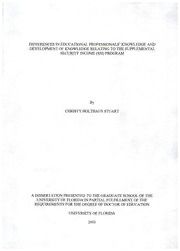Table Of ContentDIFFERENCESINEDUCATIONALPROFESSIONALS’KNOWLEDGEAND
DEVELOPMENTOFKNOWLEDGERELATINGTOTHESUPPLEMENTAL
SECURITYINCOME(SSI)PROGRAM
By
CHRISTYHOLTHAUSSTUART
ADISSERTATIONPRESENTEDTOTHEGRADUATESCHOOLOFTHE
UNIVERSITYOFFLORIDAINPARTIALFULFILLMENTOFTHE
REQUIREMENTSFORTHEDEGREEOFDOCTOROFEDUCATION
UNIVERSITYOFFLORIDA
2003
ACKNOWLEDGMENTS
Theprocessofdoctoraltraining,doctoralcandidacy,anddefendingthisresearch
projecthasencompassedmanyemotions.Ithaschallengedmyabilitytopersevere.1
mustbeginbythankingmyfamily.Mymotherhasproventomeinmorewaysthanone
whatittakestobecourageousandtolivelifewithdignityandgrace.1thankherfor
alwaysbeingoneofmybiggestfans.Myfatherhasalwaysinstilledinmethateducation
ismyfoundationtosuccess.Forhisbeliefinme,1mustthankhim.Inadditiontomy
parents,AldenandBethStuarthavegivenmesuchstrengthandsupportduringmy
doctoraltraining.Theirappreciationandrespectforeducationhasalwaysbeenasource
ofstrengthformewhileIcompletedmystudy.
IwouldliketothankStephanieLevine,whosecourageanddrivetoleada
beautifullifedespitethechallengesofherdisabilityhavealwaysbeenaninspiration.Itis
becauseofherthatIpursuedspecialeducationandstrivetocontributetothelivesof
youngadultswithdisabilities.Ithankherforherbeautifulsoulandfriendship.Special
thanksgotoDr.MeredithDelk-Pruiettforherwisdom,support,andbeliefthatI,too,
couldsuccessfullydefendmydissertation.Itreasureherfriendship.
IwouldliketothankDr.DavidMillerandDr.PaulSindelarforservingonmy
doctoralcommittee.Manythanksgotomychair.Dr.StuartSchwartz.Hispresenceearly
inmydoctoralprogramwaslife-changing.Iwillalwaysbegratefulforhissteadfastfaith
inmethatI,too,wouldsuccessfullyfinish.Additionalthanksgotomycochair.Dr.
DianeRyndak.Iwillalwaysbethankfulforherunyieldingpushtogetthebestoutofme
11
andtofeedmypassion.Iwillalwaysfeelfortunatetohavehadtheopportimitytowork
withsuchwonderfulmentors.Inadditiontomychairandcochair,1wouldliketothank
Dr.BillHalloran,whoseexpertise,support,andfaiththat1wouldsucceedandmakea
contributiontothepublicpolicyfieldhasmeantsomuchtome.1thankhimforhis
friendshipandsupportandhopethatourfriendshipwillbelifelong.1couldnothave
finishedwithouttheexpertiseofDr.HughBerry.Asidefromhisunderstandingof
statistics,heprovidedmewiththefinestfederalinternship.Thatsummertruly“changed
mylife”andmademeenvisionmyprofessionalpath.
Finally,1mustthankmyhusband,Mark,whohasgivenmesuchunconditional
love,support,andencouragementduringthemostchallengingofdays.Hegaveme
confidencewhendefendingmydissertationseemedlike“theimpossibledream”and1
thankmyson,Ryan,whohasshownmeinmanydifferentwayswhatitfeelsliketolove
beyondreason.Hisexistenceneverceasestoamazeandhumbleme.Lastly,Iwouldlike
tothankSara,mysweetangelinHeaven,who1knowisproudofhermommy.Ithinkof
hereveryday.
1
TABLEOFCONTENTS
Page
ACKNOWLEDGMENTS
ii
ABSTRACT vii
CHAPTER
INTRODUCTION
1 1
IntroductiontotheProblem:PostschoolOutcomesHaveNotImproved 1
LegislativeInvolvement 2
SecondaryTransitionProgramsandPractices 4
FederalFundingInitiatives 6
PostschoolOutcomes 7
SectionSummary 9
StatementoftheProblem 10
PrimaryResearchQuestions 11
RationalefortheStudy 12
DefinitionofTerms 13
DelimitationsoftheStudy 15
LimitationsoftheStudy 15
ChapterSummary' 16
2 REVIEWOFTHELITERATURE 18
Introduction 18
SelectionofRelevantLiterature 19
SecondaryTransitionProgramsforSecondary-AgeStudentswith
Disabilities 19
LegislativeMandatesforStudentswithDisabilities 19
OverviewofSecondaryTransitionProgrammingModels 24
PostschoolOutcomesforStudentswithSignificantDisabilities 25
ComponentsofTransitionProgramsforSecondary-AgeStudents
withSignificantDisabilities 28
HistoricalOverviewofFederalCashAssistancePrograms 30
RoleofVocationalRehabilitationandWorkersCompensation
Programs 3
IV
SocialSecurityActandtheEstablishmentoftheSocialSecurity
Administration 33
SupplementalSecurityIncomeProgramandItsEffectson
Secondary-AgeStudentswithDisabilities 35
ImpactoftheTicketWorkandWorkIncentiveImprovementsAct 41
EffectivePracticesoftheHomeCommunity-BasedWaiver 42
HowEducationalProfessionalsDevelopTheirKnowledge 45
Summary 49
3 METHODSANDPROCEDURES 52
Introduction 52
ResearchQuestions 52
Subjects 53
SubjectIdentification 53
ParticipationintheStudy 58
AssignmentofEducationalProfessionalstoGroups 58
ResearchInstrumentation 59
InstrumentDevelopment 60
FieldTesting 61
CodingofSurveyInstruments 61
ExpertValidation 62
ResearchProcedures 62
TreatmentofData 63
4 RESULTS 66
DataEntryandCleaning 66
SurveyResponseRate 66
DemographicInformationonGroupsofEducationalProfessionals 69
GenderofParticipants 69
RaceofParticipants 70
AgeofParticipants 71
ParticipantsByAverageHouseholdEarningsofSchoolDistrict 71
ParticipantsBySchoolDistrictDemography 73
ParticipantsByProfessionalRole 73
ParticipantsByYearsofEmploymentinSpecialEducationand
CurrentRole 75
ParticipantsByEducationLevel 75
ParticipantsByNumberofStudentsDirectlyorIndirectlyServed 77
FindingsforResearchQuestions 80
Summary 89
V
5 DISCUSSIONANDIMPLICATIONS 91
GeneralReviewoftheStudy 91
ReviewofthePurposeoftheStudy 91
ReviewoftheResearchQuestions 94
ReviewoftheMethodology 94
ReviewoftheResearchFindings 95
DiscussionoftheFindings 99
ImplicationsoftheStudy 104
SummaryoftheLimitationsoftheStudy 107
ConclusionsandRecommendationsforFutureResearch 109
APPENDIX
A MODELSOFTRANSITIONPROGRAMS 113
B TAXONOMYFORTRANSITIONPROGRAMMING 118
C SELECTIONOFBESTPRACTICES 120
D WRITTENREQUESTFORPARTICIPATIONOFDISTRICT
TRANSITIONCONTACTPERSON 121
E INFORMEDCONSENT/COVERLETTERFOROTHER
DISTRICT-LEVELPROFESSIONALS 124
F INFORMEDCONSENT/COVERLETTERFORSCHOOL
PRINCIPALS 126
G INFORMEDCONSENT/COVERLETTERFORDIRECTSERVICE
PROFESSIONALS 128
H SURVEYINSTRUMENT 130
I SURVEYMATRIX 139
J LISTOFREVIEWERSANDREVIEWERVALIDATIONPROBES 144
K EXPERTVALIDATIONQUESTIONSANDPROBES 145
REFERENCES 147
BIOGRAPHICALSKETCH 159
VI
AbstractofDissertationPresentedtotheGraduateSchooloftheUniversityofFlorida
inPartialFulfillmentoftheRequirementsforthe
DegreeofDoctorofEducation
STUDYOFTHEDIFFERENCESINEDUCATIONALPROFESSIONALS’
KNOWLEDGEANDDEVELOPMENTOFKNOWLEDGERELATINGTOTHE
SUPPLEMENTALSECURITYINCOME(SSI)PROGRAM
By
ChristyHolthausStuart
August2003
Chair: StuartE.Schwartz
Cochair:DianeLeaRyndak
MajorDepartment:SpecialEducation
Effectivetransitionplanningthatleadstoasuceessfiiltransitiontopostschool
environmentsforsecondary-agestudentswithsignificantdisabilitiesisofutmost
importance.Forsecondary-agestudentswithsignificantdisabilities,accessingthe
supportandservices(e.g.,personaleareattendant,specializedtransportationneeds,
communicationdevice)necessaryforasuccessfultransitionisespeciallychallenging.
Becauseoftheseneeds,secondary-agestudentswithsignificantdisabilitiesoften
areexeludedfromtransitionprogramsthatfocusonemployment,community
experiences,andindependentliving.Exclusionfromappropriatetransitionprograms
oftenleavesecondary-agestudentswithsignificantdisabilitiesfacingableakfuture.One
waytoachievethisisthroughenrollmentintheSupplementalSecurityIncome(SSI)
programduringthesecondaryschoolyears.Untilnow,investigatorshaveneglectedto
focusresearchonwhateducationalprofessionalswhoservesecondary-agestudentswith
vii
significantdisabilitiesknowabouttheSSIprogramandhowtheydeveloptheir
knowledge.Therefore,themajorassumptionofthestudywasthatinformationabout
educationalprofessionals’knowledgerelatedtotheSSIprogramforsecondary-age
studentswithsignificantdisabilities,andhowthatknowledgewasdeveloped,would
allowthefieldtoimprovetheknowledgeoffutureeducationalprofessionalsby
modifyingpersonnelpreparationefforts.Asampleof71educationalprofessionalswho
directlyorindirectlyservesecondary-agestudentswithsignificantdisabilitiesfromthe
stateofFloridarespondedtomailsurveys.
Resultsincludeddescriptiveanalysesforthreegroupsofeducational
professionals(districtprofessionals,schoolprincipals,schoolprofessionals)andanalysis
ofvariancetoexploredifferencesbetweengroupsofeducationalprofessionalsandtheir
responsestosurveyitems.Alargenumberofparticipantsinthisstudydidnothave
sufficientknowledgeoftheSSIprogram.Knowledgewasdevelopedinthisstudybytwo
methods(workshop/inservice,accesstoInternet)outoftheoptionsprovided.Therewere
differencesdetectedfromgroupsofeducationalprofessionalsthathadsomeknowledge
oftheSSIprogramanddevelopedtheirknowledgethroughaworkshop/inservice.There
werenodifferencesamonggroupsofeducationalprofessionalswhohadsomeknowledge
anddevelopedtheirknowledgethroughaccesstoInternet.Implicationsand
recommendationsforfutureresearcharemade.
Vlll
CHAPTER
1
INTRODUCTIONTOTHEPROBLEM
Thischapterisdividedintosevensections.Thefirstmainsectionincludesthe
introductiontotheproblemthatpostschooloutcomesforindividualswithsignificant
disabilitieshavenotimprovedoverthepastdecade.Thisinitialmainsectionis
subdividedinto(a)legislativeinvolvement,(b)secondarytransitionprogramsand
practices,(c)federalfundinginitiatives,(d)postschooioutcomes,and(e)asection
summary.Thesecondmainsectionisthestatementoftheproblemandthethirdmain
sectionstatestheprimaryresearchquestionsforthisstudy.Thefourthmainsectionisthe
rationaleofthestudyandthefifthsectiondefinestermsusedthroughoutthestudy.The
finalthreemainsectionsdescribethedelimitationsandlimitationsandthensummarize
thechapter.
IntroductiontotheProblem:
PostschoolOutcomesHaveNotImproved
Inthepastdecadeanumberofscholarshavediscussedtheneedtoimpact
positivelypostschooloutcomesforstudentswithdisabilities(Gartner&Lipsky,1987;
Reynolds&Wang,1985;Sailor,1991;Will,1986),especiallythosewiththemost
significantdisabilities(Brown,2000;Bruininks,McGrew,&Johnson,1995;Chadsey-
Rusch&Heal,1995;Chadsey-Rusch&Rusch,1996;Hughes,Rusch&Wood,1989;
Ward&Halloran,1989).Anemphasisonoutcomesisveryimportantforstudentswith
disabilitiesbecausemanyofthemleaveschoolunemployed,arelivingwithparents,and
arenotverysatisfiedwiththeirlivesandnetworkofsupport(Chadsey-Rusch&Rusch,
1
2
1996).Thesescholarssuggestedthatoutcomescanbeimprovedthroughprogramsand
practicesthatfacilitatetheinclusionofstudentswithdisabilitiesintypicalschooland
communityenvironmentsduringtheirsecondarytransitionyearsandthroughenrollment
infederallyfundedinitiativesthatsupporttransitiontoadultlife.Infact,manyeffective
practices(i.e.,community-basedinstructionandemploymentpreparation)havebeen
identifiedasbestpracticesforprovidingsecondarytransitionactivitiestoyouthwith
disabilities(Hasazi,2000;Kohler,1998;Lehman,Hyatt,&Sample,1997;Steere,1993;
Laymans,Corbey,&Dodge,1995;Williams&O’Leary,2001).Inspiteofthese
practices,postschooloutcomesforstudentswithsignificantdisabilitieshavenot
improved.Manystudentsarestillleavingschoolunemployed,lackingcommunityliving
opportunities,andexperiencingsocialisolation(Williams&O’Leary,2001).
Thefollowingsectionsdescribe(a)theinvolvementofthefederalgovernment
throughlegislationthataddressestransition;(b)secondarytransitionprogramsand
practices;(c)federalfundinginitiativesthatassistindividualsintheareaoftransitionto
adultlife,employment,andpostschooladultliving;and(d)postschooloutcomesfor
individualswithsignificantdisabilities.Followingtheseisasectionsummary.These
sectionsprovideaframeworkforthelegislationthathasshapedhowsecondarytransition
programsareimplementedaswellasaframeworkforconceptualizingdesiredoutcomes
forindividualswithdisabilitiesoncetheyexitschool.
LegislativeInvolvement
Since1990,theIndividualswithDisabilitiesEducationAct(IDEA)requiredthat
transitionobjectivesbedevelopedintheIndividualizedEducationProgram(lEP)forall
adolescentsreceivingspecialeducationservices.Basedontheindividual’spreferences

